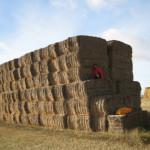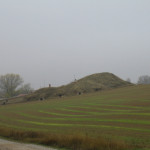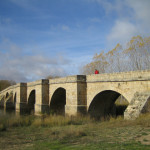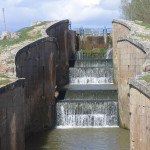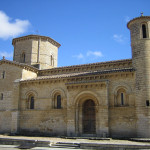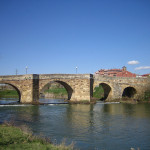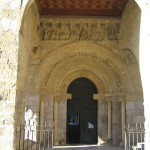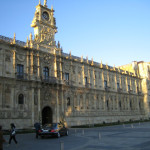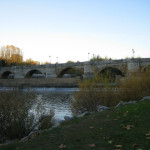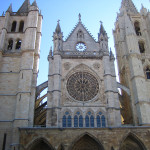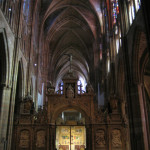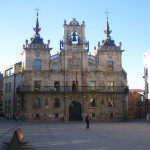The Camino Francés: Stretch 3 from Burgos to Astorga
1 pax min.
Stetch 3 from Burgos to Astorga crossing the Castilian meseta
When we speak about the St. James’s Way it is often associated with the so-called “French Way” without considering that only in Spain there are several routes to Santiago coming from different points of the Peninsula. This way, compared to others, is the busiest and the one which has the best facilities.
It dates back to the discovery of the tomb of the Apostle and the first pilgrimages to Santiago from France. It partly runs along old Roman roads that were used by the pilgrims.
Program
Day 1: Burgos
Transfer to Burgos and opportunity to visit this nice city.
Day 2: From Burgos to Hornillos del Camino, 22 km approx.
Before leaving Burgos we can visit the monastery of Las Huelgas.
This stage is the first of the so-called Spanish Meseta which we will be crossing for a few days. We leave the green landscapes of Navarra and the vineyards of La Rioja to get into the plain, warm Meseta, mainly devoted to cereal crop and very dry in summer.
We leave Burgos and walk through Rabé de las Calzadas, typical village from this section of the Camino which runs next to a paved road. We follow this track until Hornillos del Camino.
Day 3: From Hornillos del Camino to Castrojeriz, 21 km approx.
We walk through the villages of Villanueva de Argaño y Hontanas, where we can visit the parish church of Inmaculada Concepción from the 16th century. Then we reach Castrojeriz, where the battles between Christians and Saracens took place. Possibility to visit the church of Virgen del Manzano, with its origin in the 13th century.
Day 4: From Castrojeriz to Frómista, 26 km approx.
Today we finally reach the Meseta after climbing a hill on the way out of Castrojeriz.
One of the most important things we’ll find during this stage is the Puente de Itero bridge over the river Pisuerga.
We reach Frómista after going along Boadilla del Camino where we can visit its parish church. In Frómista we have the opportunity to visit the church of San Martín de Frómista, one of the most beautiful Romanesque churches in all the Camino.
Day 5: From Frómista to Carrión de los Condes, 21 km approx.
After leaving Frómista you can choose between two variants which join together again in Villalcazar de Sirga, before Carrión de los Condes. One of them runs next to a main road and the other one next to the river Ucieza. In Villalcazar there’s the possibility to visit the church of Santa María la Blanca, from 13th century.
Day 6: From Carrión de los Condes to Calzadilla de la Cueza, 18 km approx.
In Carrión de los Condes we can visit the church of Santa María del Camino and the church of Santiago.
Today part of the walk follows an old Roman road, the Vía Aquitana.
Day 7: From Calzadilla de la Cueza to Real Camino, 30 km approx.
We walk through Ledigos, Terradillo de los Templarios and Moratinos until we reach the important churches of San Lorenzo and San Tirso. From Calzadilla de los Hermanillos there are two variants, one follows a Roman road but it’s not very well waymarked and it’s longer and the other goes by Bercianos, where we will stay tonight.
If you are interested in walking the remaining part of the Roman road, it could be possible to arrange a night stay in Calzadilla de los Hermanillos instead of Bercianos del Real Camino. But there is not too much accommodation there .So in case of choosing this option we will also modify the following stages, as both variants meet in Reliegos before Mansilla de las Mulas. Please contact Viajes Orbis if you’d like to take this route.
Day 8: From Bercianos del Real Camino to Mansilla de las Mulas, 27 km approx.
After El Burgo Ranero we will reach the historic city of Mansilla de las Mulas where we can visit the parish church of Santa Maria.
Day 9: From Mansilla de las Mulas to León, 20 km approx.
Across the bridge Puente Castro dated to the 13th century over the river Esla, we finally reach León. In León we’ll have the opportunity to visit this stunning city, above all the Cathedral, the Basilica de San Isidoro, the Hostal San Marcos (nowadays a Parador) or the Casa de los Botines de Gaudí.
Day 10: From León to Villadangos del Páramo, 22 km approx.
We leave León until reaching the village La Virgen del Camino, where we can choose between two variants, we must to choose the one passing through Villadangos del Páramo and not the one through Mazarife. Both variants are nice but in Villar de Mazarife there is not good accommodation, though we can arrange it upon special petition. We must also say that the variant through Villar de Mazarife is not really well waymarked.
We have another stage with typical landscapes of the Meseta, with long plains. After walking through small villages we reach Villadangos del Páramo where we can visit the church of Santiago with the statue of “Santiago Matamoros” (St James “the Moor Slayer”) .
Day 11: De Villadangos del Páramo a Astorga, approx 29 km.
Walking through San Martín del Camino we’ll reach Hospital de Órbigo, site of knight battles which are nowadays commemorated in a local festivity.
On reaching Astorga, we can visit the Cathedral of Santa María, the Episcopal Palace of Gaudí or the city council.
Day 12: Astorga
Free day to visit the city, do some shopping and reflect about the lasts days of our trip.
Transfer to the airport.
*There is the possibility to extend the stay in Astorga, if you are interested in it please don’t hesitate to contact Viajes Orbis. When extending your stay, apart from enjoying the city, we can arrange some excursions.
*It is also posible to combine various trips, e.g. follow the Way of Saint James to Burgos, Astorga or even until Santiago or Finisterre.
- La meseta
- La meseta
- Puente sobre Rio Pisuerga
- Frómista – Canal de Castilla
- Frómista Iglesia S. Martín
- Sahagún puente
- Iglesia Sta Mª
- Parador San Marcos
- León
- Catedral de León
- Catedral de León
- Ayuntamiento de Astorga









